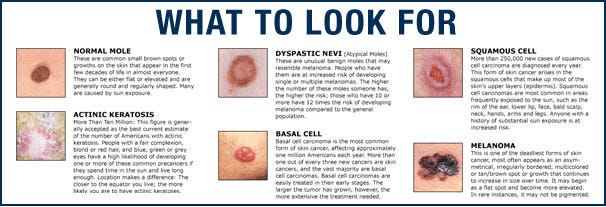Skin Cancer Moles and how to detect them
Not all moles are skin cancer moles, but some moles develop in to malignant melanoma. It is quite important to educate yourself about the signs and symptoms of skin cancer moles. Cancer moles if identified earlier, provides a warning system of cancerous growth on the skin. Knowing how to identify them also helps in the early treatment.
Skin is the largest organ in your body and it truly deserves a special care. It protects you from the harmful rays of the sun, heat, wind and cold. It is more vulnerable to diseases like skin cancers. The early signs of skin cancer are not easily detected but if you have moles they provide the warning system that you may have cancerous growth.
Moles are small growths and looks like pieces of raised or flat skin. They may be brown, red, black, skin colored, tan or reddish brown in color and may typically range from a pinhead the size of your hand.
Skin moles are nothing but a collection of pigment cells called melanocytes. Since skin cancers occurs due to the uncontrolled growth of cells in the skin, skin cancer moles can appear relatively faster in areas where no moles were seen previously or simply occur on the place of a longstanding mole.
Cancerous moles can occur anywhere in the body but are more commonly located in places that are sun exposed, particularly in the shoulders, head, neck and upper back.

The ABCDE’s of checking skin cancer moles
This is ABCDE rule of checking your moles. Here the alphabets A, B, C, D and E stands for:A stands for Asymmetry: You have to draw an imaginary line down in the middle. If both sides of the mole do not match equally, then it has to be suspected for cancerous moles.B stands for Border: A skin lesion that normally blends or fades into the normal skin may be suspicious, because a normal spot would have well defined borders. The indistinguishable borders of cancerous moles need to be explained by the doctor immediately.C stands for Colour: A change in the color of skin lesions, freckles, mole or lump may be suspicious any cancerous growth. Suspicious moles usually have 2 or 3 shades of colors which may be distributed unevenly,D stands for Diameter: A mole of diameter more than 1/4 inch would be suspicious for cancerous growth. A very rapid growth of a mole within a weeks or months may indicate skin cancer.E stands for Evolving: The existing mole or freckle, if it starts to change, then it may be suspicious for cancerous growths.In addition to this rule, one has to frequently check for the following changes in the moleSize: Check whether the mole is suddenly or continuously getting biggerSurrounding skin color: If the mole is cancerous, the skin surrounding the mole may develop colored blemishes, redness or swellings.Elevation: When a mole that was flat or slightly raised, increases in height at a rapid speed, then it can besuspicious of cancerous growth.Surface: When a mole develops erosion, scalyness or oozing, it can be suspected for cancerous growth. The signs of a more advanced disease include bleeding, ulceration or crusting.
Sensation: One of the earliestsymptoms that cancerous moles develop is the itching sensation. There may be sensations of pain or tenderness, although skin cancers are painless.
Skin cancer screening schedules
Skin cancer moles should be understood by everyone so that people might be aware of the warning signs of cancerous growth and take early treatments as soon as possible. It is always a good idea to perform self screening test on a regular basis for skin cancer moles. Look at each and every mole in the mirror and examine on the basis of ABCDE’s rule for changes in size, shape and color. Other indications of skin cancers may include itching, bleeding or tenderness surrounding the area of the mole.
Screening for any cancerous growth can be taken as a preventive measure as majority of the skin moles tends to be benign throughout the life. If you notice any irregularities, do not hesitate to visit your physician. The Doctor can make thorough examinations to determine whether skin cancer mole exist or not and treat you accordingly.
While screening for skin cancer, one should use full length mirrors. Then start from the head and work your way towards down to all parts of the body, including front, back, side, fingernails and toe nails. The hidden areas in the body like areas between fingers and toes, groin, soles and knee back should also be examined thoroughly.
Do not forget to check scalp and neck. You should keep track on all the moles in your body as well as how they look like. Taking a snap will help to check whether the moles have changed in size, shape and appearance.
If you find any changes in the existing moles or new moles that are suspicious, take an immediate appointment with a physician who specializes in skin cancer treatment and get treated immediately. Skin cancer moles if identified at the early stage can be treated successfully.
Originally published at http://www.akwa.be/blog-prive-sauna-akwa/skin-cancer-moles/.